Mandalay & Vicinity
Mandalay (City of Gems)
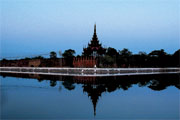 Mandalay
is located in the central dry zone of Myanmar by the
Ayeyarwaddy river. Mandalay lies along the Sagaing Fault, a
tectonic plate boundary between the India and Sunda plates.
It was the royal capital of the last monarchy of Myanmar.
The city earned its name after the 236m high Mandalay Hill.
Mandalay is famous for its beautiful wood curving and
masterpieces of Myanmar Masonry. Mandalay is Myanmar's
Religious center of Buddhism, having numerous monasteries
and more than 700 pagodas. At the foot of Mandalay hill sits
the world's official "Buddhist Canon", also known as the
world's largest book, in Kuthodaw pagoda. There are 729
slabs of stone that together are inscribed with the entire
Buddhist canon, each housed in its own white stupa. With its
royal palace and impressive moat sitting at the foot of a
high, pagoda-topped hill, Mandalay still evokes images of a
romantic, bygone era. Nearby Mandalay Hill is crowned by a
pagoda from which visitors can enjoy a 360-degree view of
the city and surrounding countryside. Mandalay
is located in the central dry zone of Myanmar by the
Ayeyarwaddy river. Mandalay lies along the Sagaing Fault, a
tectonic plate boundary between the India and Sunda plates.
It was the royal capital of the last monarchy of Myanmar.
The city earned its name after the 236m high Mandalay Hill.
Mandalay is famous for its beautiful wood curving and
masterpieces of Myanmar Masonry. Mandalay is Myanmar's
Religious center of Buddhism, having numerous monasteries
and more than 700 pagodas. At the foot of Mandalay hill sits
the world's official "Buddhist Canon", also known as the
world's largest book, in Kuthodaw pagoda. There are 729
slabs of stone that together are inscribed with the entire
Buddhist canon, each housed in its own white stupa. With its
royal palace and impressive moat sitting at the foot of a
high, pagoda-topped hill, Mandalay still evokes images of a
romantic, bygone era. Nearby Mandalay Hill is crowned by a
pagoda from which visitors can enjoy a 360-degree view of
the city and surrounding countryside.
Inwa (Ava)
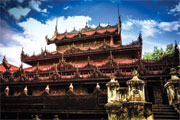 Of
all the many capital cities of Myanmar, Innwa was once achieved
international renown. Even the whole nation of Myanmar became
well known in England, France and America as the Kingdom of
Innwa during the early Konbaung period in the 19th century.
Innwa lies at the confluence of the Ayeyarwaddy and Dothtavati
Rivers just a few miles south of present Mandalay. Inn
flourished for nearly 300 years bringing fourth its culture and
literature to the highest pitch. In 1364, Innwa got its first of
four turns as Myanmar capital when Sagaing across the river fell
to the Shan. Innwa means "mouth of the lake" but the site has
also been known less modestly as "City of Gems". Of
all the many capital cities of Myanmar, Innwa was once achieved
international renown. Even the whole nation of Myanmar became
well known in England, France and America as the Kingdom of
Innwa during the early Konbaung period in the 19th century.
Innwa lies at the confluence of the Ayeyarwaddy and Dothtavati
Rivers just a few miles south of present Mandalay. Inn
flourished for nearly 300 years bringing fourth its culture and
literature to the highest pitch. In 1364, Innwa got its first of
four turns as Myanmar capital when Sagaing across the river fell
to the Shan. Innwa means "mouth of the lake" but the site has
also been known less modestly as "City of Gems".
Amarapura
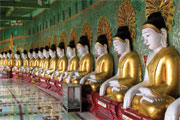 Amarapura
lies to the south west of Mandalay and north of Innwa. It was
founded by King Bodawpaya in 1785. After forty years, King
Bagyidaw shifted the capital to Innwa , and Amarapura was left
desolated. It was not long after that King Tharrawaddy restored
the old capital in 1838. The descendents of the second founder
of the city remained in the capital for another 59 years, until
King Mindon established a new capital at the foot of Mandalay
Hill. Amarapura
lies to the south west of Mandalay and north of Innwa. It was
founded by King Bodawpaya in 1785. After forty years, King
Bagyidaw shifted the capital to Innwa , and Amarapura was left
desolated. It was not long after that King Tharrawaddy restored
the old capital in 1838. The descendents of the second founder
of the city remained in the capital for another 59 years, until
King Mindon established a new capital at the foot of Mandalay
Hill.
Mingun
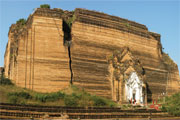 It
is home to unique pagodas. It is a compact river site village
that makes a popular half-day excursion form Mandalay by boat.
The places to see in Mingun are Mingun Pahtodawgyi (unfinished
pagoda with the world largest pile of bricks), Mingun bell
weighing 55555 viss (90 tonnes, the world largest uncracked
bell), Hsinbyume Pagoda surrounded by 7 wavy whitewashed
terraces representing the seven mountain ranges around Mt.Meru. It
is home to unique pagodas. It is a compact river site village
that makes a popular half-day excursion form Mandalay by boat.
The places to see in Mingun are Mingun Pahtodawgyi (unfinished
pagoda with the world largest pile of bricks), Mingun bell
weighing 55555 viss (90 tonnes, the world largest uncracked
bell), Hsinbyume Pagoda surrounded by 7 wavy whitewashed
terraces representing the seven mountain ranges around Mt.Meru.
Sagaing
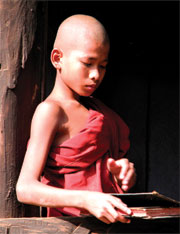 Sagaing
would be easily overshadowed by its more historically and
culturally famous neighbours: Mandalay, Amarapura and Innwa.
Sagaing lies on the right bank of Ayeyarwaddy river, at the
opposite of Mandalay. It was founded by King Athinkaya Saw
Yun, Son of Sihasu in 1315 A.D., after the fall of Bagan.
There are a great number of stupas, monasteries and
nunneries in the area of Sagaing. As you across the
Ayeyarwaddy on the busy new bridge, Sagaing's uncountable
white-and-gold stupas shinning under the sun on a series of
hillocks that rise behind the flat down. Sagaing
would be easily overshadowed by its more historically and
culturally famous neighbours: Mandalay, Amarapura and Innwa.
Sagaing lies on the right bank of Ayeyarwaddy river, at the
opposite of Mandalay. It was founded by King Athinkaya Saw
Yun, Son of Sihasu in 1315 A.D., after the fall of Bagan.
There are a great number of stupas, monasteries and
nunneries in the area of Sagaing. As you across the
Ayeyarwaddy on the busy new bridge, Sagaing's uncountable
white-and-gold stupas shinning under the sun on a series of
hillocks that rise behind the flat down.
|
|
|